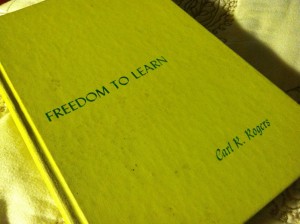Each February for the past 3 years I head to St. Dorothy’s Rest in Occidental to gather with a group of open-hearted and conscious women for four days. Our goal is to set our intentions for the coming year. It was during this year’s retreat that I stumbled upon the missing piece between my philosophy about education and turning it into something real where the rubber meets the road. I’ve been in search of that connector between the natural way an individual learns and creating an environment that allows each individual to learn in the way she needs to. In a one-to-one situation that can be doable, but with a group or even a student body of two – as I was finding out – it’s more than difficult…it felt just this side of impossible.
When you’re on retreat pretty amazing things happen. So frequently, in fact, that you stop being surprised when something you’ve been searching for, maybe even for years, is suddenly right in front of you. This is how I reached out and touched the missing piece. I was stretching on the floor of my cabin tucked into a ring of towering redwoods and while I lay back stretching out a quadricep I turn my head to stare at the bookshelf. The books are pretty old and are not a conscious collection, but the results of donations over the years. As I glance down the shelf at the titles I land on one that looks intriguing. The title is “Freedom to Learn” written by Carl Rogers (the same Carl Rogers that wrote “On Becoming A Person”). It was published in 1969. I read the first page. It starts like this:
“I am writing this book because I want to speak to teachers, professors, educators, administrators of schools, colleges, and educational institutions. But what is it I want to say to them? I sit here in my study puzzling over this question. Such a flood of thoughts and feelings flows over me that I have no idea where to begin. Then the thought begins to emerge – I want to speak to them about learning. But not the lifeless, sterile, futile, quickly forgotten stuff which is crammed into the mind of the poor helpless individual tied into his seat by ironclad bonds of conformity! I am talking about LEARNING – the insatiable curiosity which drives the adolescent boy to absorb everything he can see or hear or read about gasoline engines in order to improve the efficiency and speed of his “hot rod”. I am talking about the student who says, “I am discovering, drawing in from the outside, and making that which is drawn in a real part of me.”
Yes! He had my attention. This is what has plagued me since those first days as a teacher in a classroom and again, now, with my own two children. Whether working with my own children or someone elses, I have struggled with the conflict of supporting them in their own discovery process, while at the same time being weighed down with the externally driven need that there’s this body of knowledge that they MUST learn. How do I bring those two pieces together in a meaningful way? Is it even possible?
It became clear that what was being offered in “Freedom to Learn” was the missing piece. Rogers is committed to approaching learning from an individual-centered perspective and then moving out from there. Right off the bat in Part I of the book, Rogers offers three case studies of teachers creating structures for their students that allow the students to take responsibility for their own learning.
And that is exactly what I hoped for with my children. I modified my goal for the year. Now it was, “to create an environment where my children love learning and take responsibility for their own learning process”.
It was that moment of epiphany where all I had been figuring out and struggling with falls into neat stacks and suddenly makes perfect sense. Now I had the tools to create the structure needed for Rue and Gigi to blossom.
Details next post…

